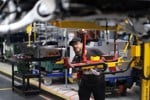The commercial fleet industry is calling on the next Government not to punish it at the pumps by increasing fuel duty on diesel.
The duty has been frozen since it was reduced by 1p per litre (ppl) in 2011. But, it remains the highest in Europe at 57.95ppl, representing a huge cost to business and, according to the Road Haulage Association (RHA), a massive tax on the entire supply chain.
The logistics sector pays 35% of fuel duty collected by the Treasury and contributes more than £121 billion Gross Value Added (GVA) to the UK economy. Annual turnover is estimated at £1 trillion, while it also employs more than 2.5 million people nationwide.
But, with the general election just a matter of weeks away on June 8, the Freight Transport Association (FTA), the RHA and RAC have called on all political parties not to risk economic growth by targeting diesel duty.
Publishing their own manifestos ahead of the national vote, they have put fuel duty, congestion, investment in roads and skills, road safety and a Brexit deal which delivers for the commercial fleet industry, among their chief policy concerns.
In light of a growing focus on pollution, and the publication of the current Government’s long-awaited air quality strategy (see page 6), the new Government may be tempted to discourage the use of diesel by creating a differential between fuel duty rates.
Christopher Snelling, head of national policy at the FTA, said: “The logistics sector underpins every aspect of modern life and it is incumbent on the next Government to ensure that it remains a key consideration for policy decisions, both domestically and internationally.”
However, he says, the sector should not be targeted for a pollution problem which is “the responsibility of all”. He argued: “There is no environmental purpose to increasing diesel duty on vans and lorries, as unlike diesel car drivers, operators of these vehicles currently have no realistic alternative.”
The FTA says that Government support is still required to develop the market in alternative fuel vehicles to the point where technological development and economies of scale will make them fully competitive with diesel.
For example, it says, support is required to help provide a national refuelling infrastructure for gas vehicles. Government should also consider regulatory incentives to create market conditions and encourage uptake.
Snelling continued: “Business, including the logistics sector, has made significant improvements in its environmental impacts in recent years, but there is more work to be done. It is vital the next UK Government continues to help and support freight and logistics operators.”
In 2014, a Treasury report indicated that lower levels of fuel duty help boost economic growth. It therefore follows, according to the RAC, any rise in duty from the current rate could prove damaging to the UK economy.
For this reason, the RAC’s manifesto urges the next Government to commit to no further increases in fuel duty for the entire duration of the next parliament.
RAC chief executive officer Dave Hobday said: “It is vital, with motoring taxation at record levels, that there should be a commitment not to increase fuel duty.” Otherwise he warned “it could stifle economic growth”.
However, the FTA and the RHA want the next Government to go one step further and cut fuel duty.
Research from the Centre for Economics and Business Research (CEBR) shows that if a further 3ppl fuel duty cut was introduced by the Government it would bring substantial economic benefits; rises in other tax receipts would offset losses on fuel duty
“A 3ppl reduction in fuel duty would boost the economy and be revenue neutral for the Government,” said Snelling. “The resulting additional spending would reinvigorate the economy.”
In its manifesto, the RHA argues: “High duty drives up costs for companies and consumers, undermining the competitiveness of the UK and undermining the working capital of businesses.
“The impact in the more remote areas of the UK – further from suppliers and major markets – is especially damaging. The next Government needs to reduce the differential between duty rates in the UK and the rest of the EU.”
NOx emissions from HGVs are estimated to have fallen by one third in the past three years and continue to fall as new Euro VI HGVs replace older vehicles.
The FTA’s manifesto says the biggest challenge during the next Parliament will be how quickly can the cleanest ‘Euro VI/6’ lorries and vans be deployed in the cities with the highest local pollution levels.
The Government, it says, should offer support to businesses affected to both speed up the use of the cleanest diesel vehicles and to enable firms to cope with the transition to Clean Air Zones (CAZs).
The RHA wants the removal of restrictions that force trucks to use congested roads at peak times and a “realistic scrappage scheme” for hauliers operating pre-Euro VI HGVs.
Another key policy to cut emissions, according to the FTA, would be reducing the amount of road freight journeys by enabling modern load-efficient vehicles to be used on the trunk road network; carrying more of the goods the UK requires in each single vehicle movement.
The ‘Longer Semi Trailer’ now being trialled is delivering this concept.
Government should allow research and testing of load-efficient road freight concepts to assess safety and environmental performance, says the FTA.
Snelling added: “The industry deserves the full support of the Government as it works to ensure the continued success of UK plc, and we expect whichever party is successful in next month’s general election to place logistics at the heart of its economic plans.”
Investment in infrastructure ‘must continue’ irrespective of who is in power
The next Government must ensure the Roads Investment Strategy (RIS) remains protected and provides sufficient funding to deliver the full approved programme of improvements, says the Freight Transport Association (FTA).
More than 80% of goods go by road and, as the economy grows, the demands placed on the road network will only increase. However, the FTA said that the quality of the existing road network is poor and maintenance of it must be improved to reduce the cost of congestion.
The RHA said: “Congestion costs the UK economy £31bn per year and leads to increased pollution, especially in urban areas.
“In addition, poorly maintained roads cost the UK economy millions of pounds each year; the cost of repairing potholes alone has been estimated at £683m per annum and the cost in vehicle repairs is more than £675m per annum. The UK needs well-maintained roads, fit for the 21st century, to make sure UK businesses are as competitive as possible.”
The RAC wants continued investment in the strategic road network funded by ring-fencing Vehicle Excise Duty (VED).
In December 2014, the Government committed to investing £15bn in England’s strategic road network between 2015 and 2020 – known as RIS 1.
RIS 2, which comes into effect from 2021, will be funded by VED which currently generates approximately £6bn per year for the Treasury. This figure is expected to increase further from 2020-21.
With RIS 1 well underway, the RAC wants the next Government to commit to the development and delivery of RIS 2, the on-going hypothecation of VED to fund it and future roads investment strategies to cope with the rising demand expected on the network.
Both the FTA and RHA are also calling for rest facilities for drivers to be improved. “Driver roadside facilities are poor for both overnight parking and 45-minute breaks, hampering the effectiveness of logistics operations and the attractiveness of lorry driving as a profession,” the FTA says in its manifesto.
“Government must ensure that highways authorities are provided with support for the development of new, and improvement of existing, roadside facilities for drivers. We recognise recent steps taken to improve provision. However this is nowhere near enough and much more needs to be done.”




















Login to comment
Comments
No comments have been made yet.